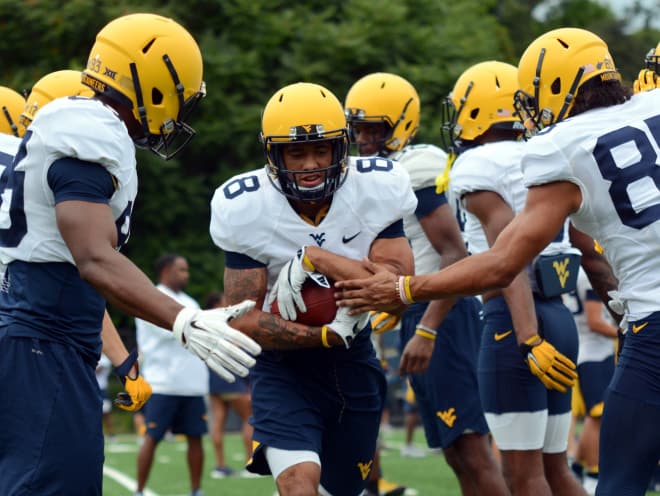Simms back at the right time with WVU seeking depth at WR

Sunday night’s season opener unveiled one of West Virginia’s key weaknesses on offense: depth at the wide receiver position.
West Virginia’s main receiving corps consisting of juniors David Sills, Gary Jennings and redshirt senior Ka’Raun White combined for 26 receptions for 357 of the team’s 371 yards through the air and three touchdowns in Sunday night’s loss to Virginia Tech.
“There’s a fatigue aspect to it and we need more bodies,” West Virginia head coach Dana Holgorsen said. “That’s why I’ve been complaining about backup receivers for a long time.”
There’s no doubt that the Mountaineers have a talented and reliable main receiving corps, but the team will find itself in trouble if its backup receivers cannot produce alongside the team’s primary wide receivers.
So, who is most likely to step up at receiver?
Luckily for West Virginia, sophomore wide receiver Marcus Simms, who was suspended for the season opener following an August arrest, will return to action this week.
Simms’ presence on the field will not only provide the receiver position with some much needed depth, but he will also give the West Virginia offense the speed and deep threat ability that the Mountaineers have been missing at the receiver position.
“He can flat out fly,” West Virginia receivers coach Tyron Carrier said. “That always helps take some pressure off of the intermediate routes and it backs the defense up so we can run the ball better also.”
That presence on the outside is going to allow the Mountaineers to stretch the field as well as have another proven body that will be able to relieve stress off starters.
Behind Sills, Jennings, White and Simms is a line of youth and inexperience, but the backup unit does contain the talent and skill set that can aid West Virginia’s passing game.
True freshman Reggie Roberson looks to be the team’s No. 5 receiver. Roberson led all West Virginia backup receivers with just one reception for seven yards against Virginia Tech. Similar to Simms, Roberson’s speed makes him another deep threat that the offense can utilize in the passing game.
“He’ll be a guy that can stretch the field also,” Carrier said. “His snaps will definitely pick up.”
After Roberson, the next receiver to most likely step up and take on a bigger role in the passing game is redshirt junior Ricky Rogers. The Monroeville, Pa. native only has two catches for 51 yards in four appearances, but seems like a viable option as an outside receiver based on his amount of time in the program compared to the other players on the depth chart.
“They’re going to get there,” Carrier said. “It just takes a little time.”
It’s also possible that West Virginia will look to get its running backs involved more in the passing game out of the backfield as a result of the thin depth at wide receiver.
Sophomore running back Kennedy McKoy is a versatile option for the Mountaineers when it comes to receiver. He’s taken reps as a slot receiver during practice, but saw very little action in the passing game against Virginia Tech, hauling in two catches for only four yards.
Freshman Tevin Bush is another versatile player for West Virginia that has taken reps as a slot receiver and could see more action in the passing game. Bush amassed more than 2,500 all-purpose yards in high school and caught one pass for four yards in Sunday’s loss.
Finding some depth and productivity at from West Virginia’s backup wide receivers is something to watch from here on out. If no one steps up soon, the team’s main corps will continue to play the majority of offensive snaps, allowing more room for opposing defenses to exploit West Virginia’s weakness of lack of depth at the position.

